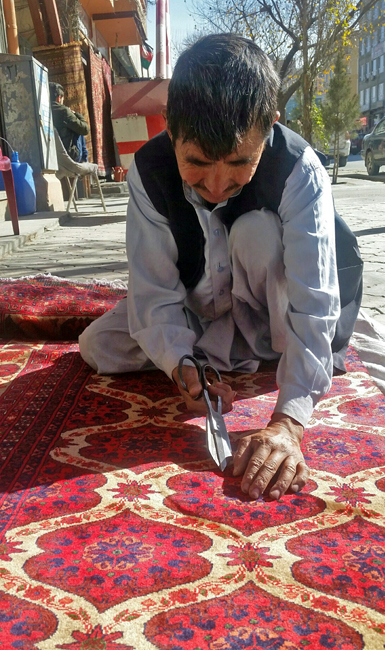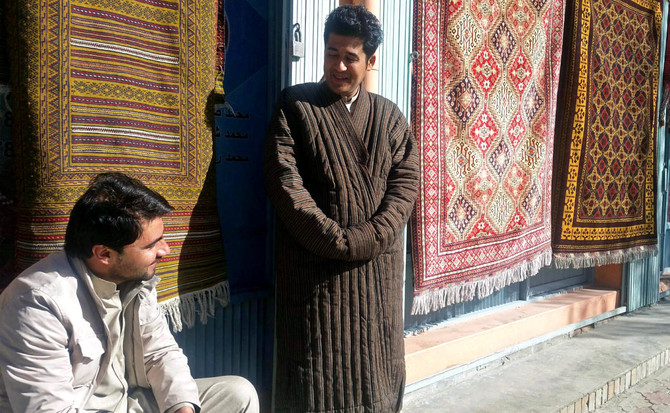KABUL: Afghanistan’s signature carpet-weaving industry faces a sharp decline in production, leading to a dent in the country’s economy and bringing the trade to extinction for many families associated with it for generations.
For centuries, hundreds of thousands of Afghans benefited from the income of elegant hand-woven rugs — the major source of the country’s legal earnings from export of the pieces, known across the world for their design, texture, softness and natural dyes.
However, prolonged war and the emergence of machine-made, colorful and easily affordable carpets led to a sharp fall in the export of handwoven carpets and rugs, which in return badly affected their production, according to Afghans involved in the trade.
One survey showed that competition in adjacent countries, and the fact that the Afghans moved most of the industry to Pakistan because of war, have been among other factors for the decline of production at home.
“On average, we have had not even 15 percent of production in the past few years, because we do not have the infrastructure and face lack of marketing in the region,” Mohammed Amin Nadem, one of the leading carpet producers, told Arab News.
The recent honeymoon period for the industry’s dealers re-emerged after the fall of the Taliban in late 2001 but lasted for only a few years.
Exports from Afghanistan rose rapidly from $4 million in 2001-2002 to $216 million in 2005-2006, the estimates of the survey showed. The export trend considerably slumped to less than $35 million in the years that followed, the Afghan officials said.
The Afghan carpets are made mostly in northern and western parts of the country by different ethnic groups, with each area having a distinct pattern, from the octagonal elephant foot in the north, known as Bukhara print, to trappings of nomadic life and the elongated human and animal figures in western Afghanistan, mainly the Herat province.

An Afghan carpet seller snips the threads of a carpet in Kabul on Dec.7th.
(AN photo by Sayed Salahuddin)
“Apparently, the decline in exports affected carpet production at the domestic level, specifically in the northern region, where the major portion of Afghan carpets is manufactured. The Kunduz province alone suffered from a decline in carpet production by more than 50 percent, which had a detrimental effect on the livelihood of the carpet weavers. Faryab province suffered from a decline in carpet production by nearly 40 percent,” the survey said.
“We used to produce at least 2 million sq meters annually then, and now I believe the production is possibly below 200,000,” said Nadem, whose factory has woven carpets depicting faces of world leaders such as Barack Obama and George W. Bush, former US presidents.
Owing to the deteriorating economy and the mushrooming production of machine-made carpets in the region, far fewer Afghans can afford the locally produced ones, the dealers said.
Landlocked Afghanistan this year opened an air corridor for exporting its famous fresh and dry fruits to India, but exporting carpets by air freight would make the costs soar, Nadem said.
In a major boost for the multimillion-dollar regional trade, lately a historical window of opportunity opened for Afghanistan when the Chabahar sea port was inaugurated on the border with Iran.
It can also be used as a route for the export of Afghan carpets to its old traditional customers in Europe, America and the rest of the world, analysts said. However, they said the government needed to revive confidence and open up opportunities for the frustrated producers.
As part of a move to prevent the fall of the carpet industry many years ago, the government allocated hundreds of hectares of land for building a first major industrial park for production of carpets and to accommodate Afghan families who have been producing carpets and living in Pakistan, but there has been no progress on the project to date, Nadem said.
Afghanistan’s famous hand-woven carpet production is in rapid decline
Afghanistan’s famous hand-woven carpet production is in rapid decline

Incoming: The biggest movies due out before summer 2026

- From Baby Yoda’s big-screen debut to the return of Miranda Priestly, here are some of the biggest films heading our way in the next few months
‘Project Hail Mary’

Directors: Phil Lord, Christopher Miller
Starring: Ryan Gosling, Sandra Huller, Lionel Boyce
Due out: March
MGM paid a reported $3 million to acquire the rights to this 2021 sci-fi novel by Andy Weir (author of “The Martian”), which has now been adapted for this blockbuster starring Gosling as Dr. Ryland Grace. Grace wakes up on a spacecraft with no memory of who he is or why he’s there. He gradually works out that he’s the sole survivor of a crew sent to the Tau Ceti solar system hoping to find a way to fix the results of a “catastrophic event” on Earth. Fortunately, it turns out Grace is kind of a science genius. Equally fortunately, it turns out he may not have to save the world all on his own.
‘Good Luck, Have Fun, Don’t Die’

Director: Gore Verbinski
Starring: Sam Rockwell, Haley Lu Richardson, Michael Pena
Due out: January
After its premiere at Fantastic Fest last year, Variety described Verbinski’s sci-fi action comedy as “an unapologetically irreverent, wildly inventive, end-is-nigh take on the time-loop movie” with a “hyper-referential script … full of inside jokes for gamers.” The guy stuck in that time loop is Rockwell’s man from the future, who’s on his 118th attempt to save the world from a rogue artificial intelligence. To do so, he needs to convince just the right mix of misfits from the late-night patrons of a diner in Los Angeles to undertake what could well be a suicide mission.
‘Wuthering Heights’

Director: Emerald Fennell
Starring: Margot Robbie, Jacob Elordi, Hong Chau
Due out: February
Fennell’s latest feature is billed as a “loose adaptation” of Emily Bronte’s 1847 Gothic classic —the story of the ill-fated passion shared between the well-to-do Catherine Earnshaw and Heathcliff, a young man of low social standing and uncertain ethnic origins, in the moorlands of Yorkshire in northern England. Warner Bros. are playing up the love-story side of Bronte’s layered and often troubling novel, setting a Valentine’s week release.
‘The Super Mario Galaxy Movie’

Director: Aaron Horvath, Michael Jelenic
Voice cast: Chris Pratt, Anya Taylor-Joy, Charlie Day
Due out: April
Critics were not especially kind to 2023’s “The Super Mario Bros. Movie,” but that certainly didn’t dissuade audiences, who made it the second-highest grossing film of that year, behind only “Barbie.” With the same team returning to helm and voice the movie (with the additions of Benny Safdie and Brie Larson to the cast), chances are that “Galaxy” will have much the same reaction from the two groups as the eponymous Brooklyn plumber and his brother Luigi head into outer space with Princess Peach and Toad to take on Bowser’s son, Bowser Jr (Safdie).
‘Michael’

Director: Antoine Fuqua
Starring: Jaafar Jackson, Nia Long, Miles Teller
Due out: April
The biggest biopic of the year will likely be this feature about one of the most culturally significant music stars in history, Michael Jackson — aka The King of Pop. It depicts his journey from child star in the Jackson 5 to global superstar in the Eighties, and reportedly does not whitewash the allegations of child sexual abuse that dogged the singer for years (with producer Graham King saying he wanted to “humanize but not sanitize” Jackson’s story) — although Michael’s own daughter, Paris, has described the script as “sugar-coated” and “dishonest.”
‘The Devil Wears Prada 2’

Director: David Frankel
Starring: Meryl Streep, Anne Hathaway, Emily Blunt
Due out: May
With all the original stars returning (despite the reported initial reluctance of Streep and Hathaway to do so) along with the director and main producer, this sequel to the acclaimed 2006 comedy drama about aspiring journalist Andrea “Andy” Sachs (Hathaway), who lands a job as PA to an absolute nightmare of a fashion-magazine editor — Miranda Priestly (Streep) should be a guaranteed hit. If it sticks to the story of Lauren Weisberger’s “Revenge Wears Prada: The Devil Returns,” then we’ll find that Andy, a decade on, is now herself the editor of a bridal magazine and planning her own wedding. But she’s still haunted by her experiences with Miranda.
‘The Mandalorian and Grogu’

Director: Jon Favreau
Starring: Pedro Pascal, Sigourney Weaver, Jeremy Allen White
Due out: May
The latest feature from the “Star Wars” franchise builds on one of its most successful TV spinoffs, “The Mandalorian.” It sees bounty hunter Din Djarin (aka The Mandalorian) and his one-time target-turned-adoptive son Grogu — the Force-sensitive infant from the same species as the Jedi master Yoda — enlisted by the New Republic to help them combat the remaining Imperial warlords threatening the galaxy after the collapse of the Galactic Empire.











